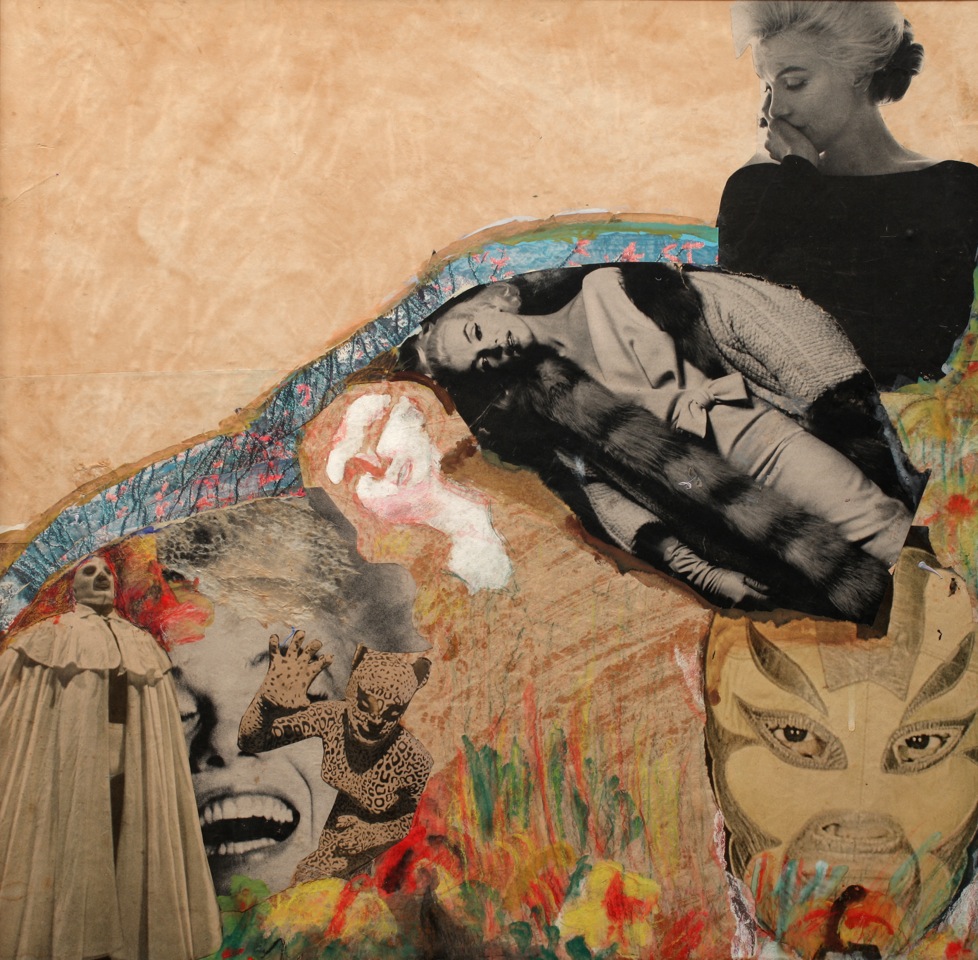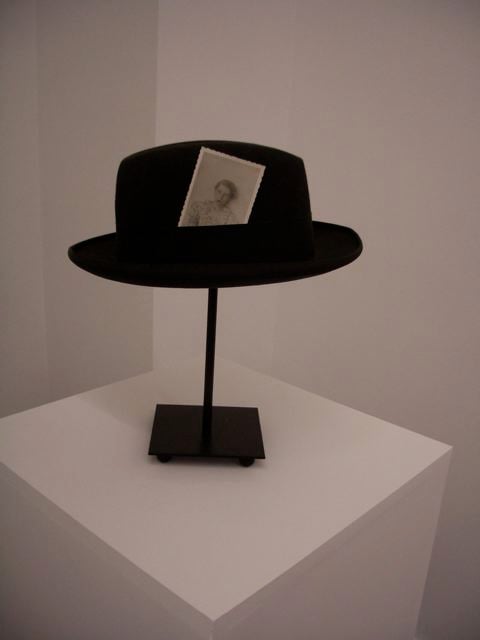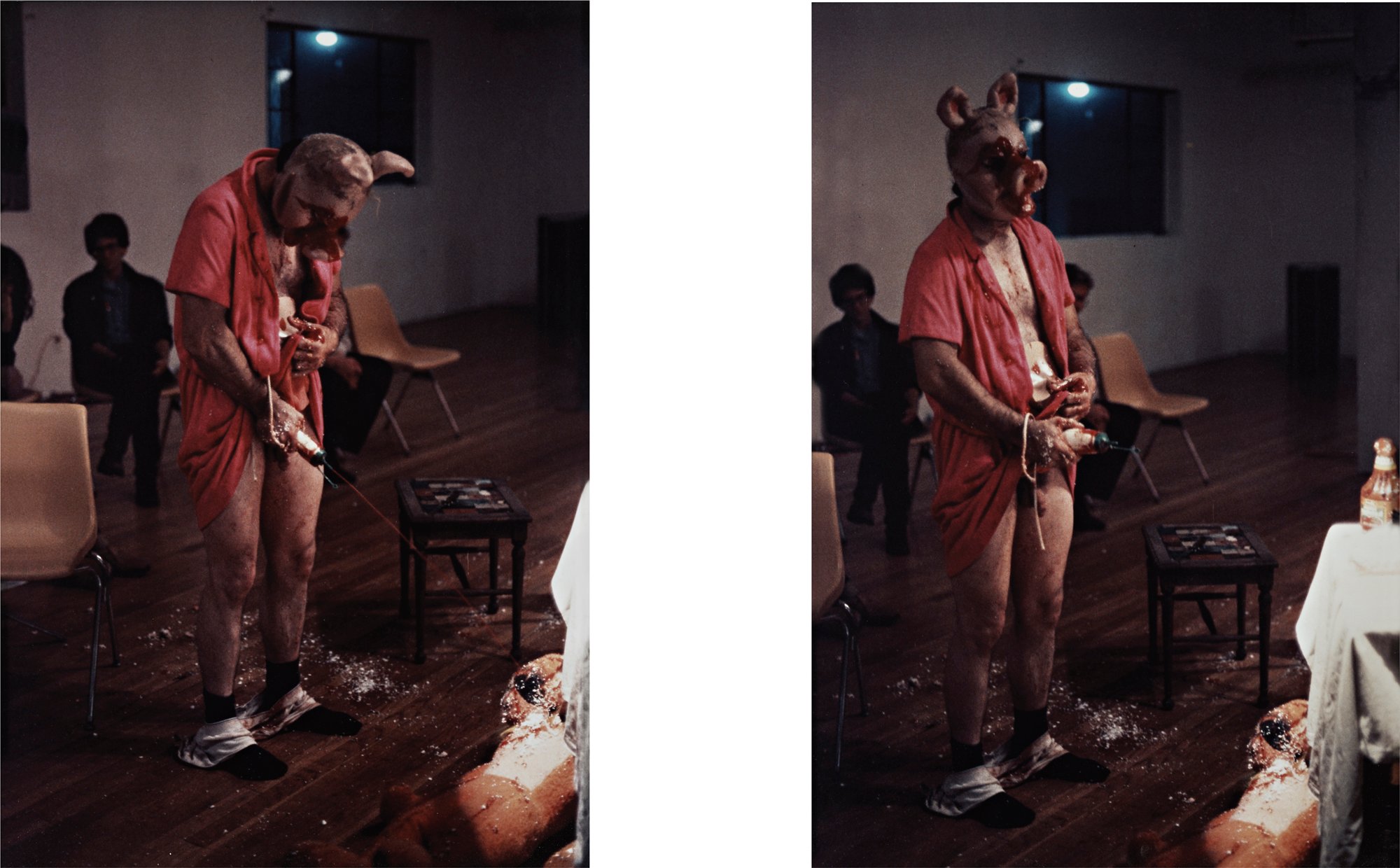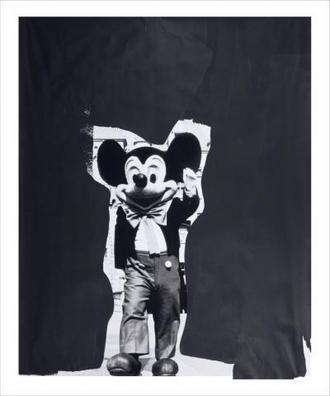
© » KADIST
Native Art Department International
The neon sign Walk the Walk (Sam Durant) overlays a Walk/Don’t Walk Sign crosswalk sign onto the text “You Are On Indian Land Show Some Respect.” The sign asks viewers to not walk on Indigenous lands without respecting it, and, switching between a walking person icon in white and a raised hand icon in red, redirects their actions. This work by Native Art Department International signals a reminder that we–the audience and institution–are located on and occupy traditional territories. The work appropriates and twists white artist Sam Durant’s You Are On Indian Land Show Some Respect (2008) in response to his work Scaffold (2012) installed in 2016-7 at the Walker Art Center in Minneapolis.

© » KADIST
Bili Bidjocka
The short two-channel video Pause/Tanmpo takes its cue from a coincidental encounter artist Bili Bidjocka had in Dakar. Walking down the corniche, he saw a boxer, a Senefalese man, training at the beach. It immediately reminded the artist of Le Boxeur—the most well-known brand of matchsticks in Cameroon.

© » KADIST
Mona Benyamin
A moonscape is a vista of the lunar landscape or a visual representation of this, such as in a painting. The term “moonscape” is also sometimes used metaphorically for an area devastated by war. Moonscape by Mona Benyamin is inspired by and dedicated to the Lunar Embassy—a company that now sells land on a variety of planets and moons, established in 1980 by a man called Dennis M. Hope, who claimed ownership of the Moon.

© » KADIST
Hwayeon Nam
Imjingawa is Hwayeon Nam’s first foray into borrowing from the documentary form. The root of the work is a Japanese song with Korean diasporic connotations, which the artist heard inadvertently years ago. While tracking the inception and history of the song, her research explored the song’s potential to live beyond “legal, national, ideological, and geographical barriers.” The song earned its fame when it was introduced to the Japanese band, the Folk Crusaders.

© » KADIST
Gala Porras-Kim
Drawing & Print (Drawing & Print)
The graphite drawing 4 mourners on a mantel by Gala Porras-Kim is part of a larger installation and body of research, entitled An Index and Its Settings (Un Índice y Sus Entornos) , in which the artist reconsiders 235 ancient burial figures (from circa 200 BCE – 50 CE) from what is now Mexico’s Pacific coast that are part of the Proctor Stafford Collection held by the Los Angeles County Museum of Art (LACMA). Eschewing their current musicological function, 4 mourners on a mantel presents photo-realistic depictions of said figures on top of a hypothetical collector’s fireplace. Herein, these funerary objects are displaced as curios which stare back at the viewer in signs of grief and confusion.

© » KADIST
Yuyan Wang
One Thousand and One Attempts to Be an Ocean by Yuyan Wang reflects on the experience of not being able to see the world with depth perception. Made up of micro-events from ‘satisfying videos’ that swarm on the internet, the abstract narrative unfolds through layers of appropriation; referencing trance and minimal music in the process. The work addresses a desire for groundless waves, blended with today’s inexorable entropy of information societies.

© » KADIST
Matti Braun
During a residency in 2009 at L’appartement 22 in Rabat, the artist traveled in Morocco and Senegal on the traces of the German sculptor Arno Breker. On this occasion he learned about batik, a fabric printing technique which originates not only from Indonesia but also from Senegal. It is also widespread in Africa.

© » KADIST
Duane Linklater
silentstar, delicacy by Duane Linklater is a replica of a baby pink hoodie that the artist wore as a teenager, embellished with hand-painted elements and band patches. From associations with punk and hip-hop to skater culture, the hoodie has a history of being adopted by youth-driven communities once relegated to the fringes, and being embraced by mainstream fashion as a practical article of clothing, which Linklater’s work complicates even further. The reproduction is made with dye extracted from cochineal insects.

© » KADIST
Karla Kaplun
Drawing & Print (Drawing & Print)
Studying the body in movement, this series of drawings depart from Karla Kaplun’s work A ztec BLAST® Workout (AWB) . Taking the form of a fitness training program, this work critically explores issues of cultural appropriation, focusing on the traditional “Conchero” Aztec dance. The Concheros dance—also known as the Chichimecas, Aztecas and Mexicas—is an important traditional dance and ceremony which has been performed in Mexico since early in the country’s colonial period.

© » KADIST
Little Warsaw
Jaali – Horizontal references religious practices in Hungary that were considered as a civil disobedience throughout the 1950s. In their text associated to the work the artists state: “My ancestors on my father’s side were rather elegant Hungarian noblemen—lots of churches, lots of religious education. My parents went to church as a form of civil resistance.

© » KADIST
Karla Kaplun
Drawing & Print (Drawing & Print)
Studying the body in movement, this series of drawings depart from Karla Kaplun’s work A ztec BLAST® Workout (AWB) . Taking the form of a fitness training program, this work critically explores issues of cultural appropriation, focusing on the traditional “Conchero” Aztec dance. The Concheros dance—also known as the Chichimecas, Aztecas and Mexicas—is an important traditional dance and ceremony which has been performed in Mexico since early in the country’s colonial period.

© » KADIST
Akram Zaatari
“In the 1980s I started using coloured paper backdrops, one of which was yellow. You can see they never reached the floor. I used them for colour and black-and-white photography.” Hashem El Madani.

© » KADIST
Fran Herndon
Working independently, Herndon experimented at the forefront of a now-canonical method—appropriation—by painting additions into found images from magazines such as Life and Sports Illustrated in a way that imbues the resulting works with mythical significance. Associated with the Beat movement, her work is integral to that part of the history of San Francisco. White Angel (1962), painted in the year of Marilyn Monroe’s death, portrays the actress in a process of devolution.

© » KADIST
Gabriel Sierra
Untitled consists of a small wooden sculpture that leans against a wall. Here, a rectangular piece of wood holds a folded article from a vintage design magazine whose Italian text states: “Villa per una persona sola. Arquitectura Pasadena California.” On the flipside of the paper is a feature with different images of paintings and architecture, including a painting by Piet Mondrian.

© » KADIST
Felipe Dulzaides
I Am Cuba— “Soy Cuba” in Spanish; “Ya Kuba” in Russian—is a Soviet/Cuban film produced in 1964 by director Mikhail Kalatozov at Mosfilm. The movie was not well received by the Russian or Cuban public and was almost completely forgotten until its rediscovery thirty years later by American filmmakers. The movie’s acrobatic tracking shots and idiosyncratic mise-en-scène prompted Hollywood directors like Martin Scorsese to campaign to restore the movie in the early 1990s.

© » KADIST
Ming Wong
Making Chinatown (2012) is a remake of Roman Polanski’s 1974 classic neo-noir film Chinatown . According to Wong, the latter is a “textbook” of Hollywood filmmaking . In Ming’s version, he plays all four main characters portrayed originally by Jack Nicholson, Faye Dunaway, John Huston, and Belinda Palmer, shooting against a backdrop of a film set reproduced as wallpaper in a gallery space.

© » KADIST
Luke Butler
Drawing & Print (Drawing & Print)
In Captain X , Star Trek’s Captain Kirk, played by William Shatner, is limply draped over a large boulder in what looks like a hostile alien environment. However, Kirk’s passive pose doesn’t so much suggest the aftermath of a battle as it does heavy contemplation, depression, or utter despair. Captain X is part of a series of paintings depicting various Star Trek characters who are stricken with human emotion-—a tactic that diminishes the mythological grandeur associated with this heroic captain and his indefatigable crew.

© » KADIST
Xu Tan
Drawing & Print (Drawing & Print)
Biennale, Dog is an appropriation of the posters made to promote biennial art exhibitions. Displayed alongside the official marketing materials of biennials (Shanghai, Berlin, Venice, etc.) Xu’s works provide a satiric and provocative alternative to the official system and make publicly visible images of many realities.

© » KADIST
Li Ran
In his video work Beyond Geography , Li dramatizes the role of the artist-as-imitator to the point of sheer parody. Dressed to toe in the costume of a typical Discovery Channel adventurer-explorer, the artist dashes suavely through the uncharted jungle habitat of a primitive tribe. Li modulates his own voice in laughably accurate mimicry of the dubbed Discovery Channel protagonist familiar to Chinese viewership, daringly gulping fresh water from a river, expertly admiring exotic vegetation, and whimpering in fear of the dark sounds of the night (screaming, even, as he trips on a human skull) in an full-scale exaggeration of a nature show personality.

© » KADIST
Kota Ezawa
The Crime of Art is an animation by Kota Ezawa that appropriates scenes from various popular Hollywood films featuring the theft of artworks: a Monet painting in The Thomas Crown Affair (1999), a Rembrandt in Entrapment (1999), a Cellini in How to Steal a Million (1966), and an emerald encrusted dagger in Topkapi (1964). Ezawa uses his signature cartoon-like style to remix and reenact these crime scenes, leaving only the artworks as “real” objects (as they are depicted in the films), rather than illustrating them. Reversing fiction and reality in an unexpected way, this gesture invites the viewer to question the reliability of the visual footage.

© » KADIST
Matt Lipps
Untitled (Women) (2011) presents a startlingly succinct history of violently romanticized femininity. Matt Lipps created this diptych by photographing a single arrangement of cutouts. As in his analogous portrait of men, the middle section appears twice, on either side of the split, signaling a stutter, a caesura, or a schizophrenic break.

© » KADIST
Hans-Peter Feldmann
The types of objects Feldmann is interested in collecting into serial photographic grids or artist’s books are often also found in three dimensional installations. Hats and photographs are regularly part of his appropriations and arrangements. He famously made numerous trips to England in search of old photographs when he was an antique dealer, and then worked in a gift store with his wife when he left the art world in the 1980s.

© » KADIST
Raymond Pettibon
The five works included in the Kadist Collection are representative of Pettibon’s complex drawings which are much more narrative than comics or cartoon. The images allude to recurring topics, such as the superhero (present both in Untitled Superman and No title without the comics ), a book cover (his literary sources), or a mushroom cloud. Inspired by the writings of William Faulkner, Daniel Defoe, Gustave Flaubert, Marcel Proust, and James Joyce, Pettibon’s sophisticated, witty drawings combine image and text to explore the gamut of American popular culture.

© » KADIST
Matt Lipps
In the series Horizons (2010), Lipps uses appropriation to riff on Modernism’s fascination with abstract form. For Untitled (Men) (2011), he snipped from magazines and textbooks pictures of handsome or famous men, from the ancient Greek to the modern. Arranged in a tableau, lit theatrically, and rephotographed, the two-dimensional figures have an embodied presence.

© » KADIST
Wallace Berman
While Untitled (Shuffle) presents the same formal characteristics as the rest of Berman’s verifax collages, this constellation of specific images inside the radio’s frames—the Star of David, Hebrew characters, biblical animals—have Jewish symbolism and attest to the artist’s lasting obsession with the kabala. The piece’s sub-title, “Shuffle,” suggests the presence of chance and randomness in any given organization of elements.

© » KADIST
Glenn Ligon
Drawing & Print (Drawing & Print)
Glenn Ligon’s diptych, Condition Repor t is comprised of two side-by-side prints. Though simple, each contains a nested stack of historical and self-referential quotations. Both black-and-white prints depict a version of Ligon’s 1988 painting, Untitled (I Am A Man) , which declares the words of the parenthetical in blocky black letters.

© » KADIST
Kota Ezawa
Paint and Unpaint is an animation by Kota Ezawa based on a scene from a popular 1951 film by Hans Namuth featuring Jackson Pollock. At first glance, due to the oversimplified silhouettes Ezawa employs, the connection between his animation and Namuth’s film may not be obvious. However, when seen side by side, Ezawa’s piece is a faithful reproduction of the scene—up until a point in which his sequence begins playing in reverse, effectively unpainting every brushstroke.

© » KADIST
Pak Sheung Chuen
Pak created New York Public Library Projects (NYPLP) (2008) during a residency in New York, using public libraries as exhibition spaces and the books they house as raw materials. One of the nine parts of this work is Page 22 (Half Folded Library) , a site-specific installation for which Pak covertly folded dog-ears on page 22 of every second book (a total of approximately 15,500 books) in the 58th Street Branch Library in Manhattan. By claiming it as a “solo exhibition,” Pak intentionally turned a public institution into a private and personal museum where his works are more or less a “permanent collection.” Being open-ended as far as further interpretation (or not) by readers who encounter the folded pages, the project tests the political and social potential of personal gestures in the public realm.
Matt Lipps
- location: San Francisco, California
- year born: 1975
- gender: male
- nationality: American
- home town: San Francisco, California
Kota Ezawa
- location: San Francisco, California
- year born: 1969
- gender: male
- nationality: German
- home town: Cologne, Germany
Karla Kaplun
Karla Kaplun’s practice centers on micro-utopias, the construction and functioning of collective memory, as well as mechanisms of political and economic power and control...
Martin Creed
- location: Wakefield, United Kingdom
- year born: 1968
- gender: male
- nationality: British
Glenn Ligon
- location: New York, New York
- year born: 1960
- gender: male
- nationality: American
- home town: Bronx, New York
Paul McCarthy
- location: Los Angeles, California
- year born: 1945
- gender: male
- nationality: American
- home town: Salt Lake City, Utah
Pak Sheung Chuen
- location: Hong Kong, China
- year born: 1977
- gender: male
- nationality: Chinese
- home town: Fujian, China
Ming Wong
- location: Berlin, Germany
- year born: 1971
- gender: male
- nationality: Singaporean
- home town: Singapore
Li Ran
- location: Beijing, China
- year born: 1986
- gender: male
- nationality: Chinese
- home town: Hubei Province, China
Pio Abad
In his practice, Pio Abad looks into the social and political significance of objects usually consigned to the sidelines of history...
Duane Linklater
Duane Linklater addresses issues of cultural loss and recovery, as well as appropriation and authorship articulated through sculpture, installation, photography, film, and video...
Native Art Department International
Native Art Department International is a collaborative project created in 2016 and administered by Maria Hupfield and Jason Lujan...
Bili Bidjocka
A visual artist and curator, Bili Bidjocka’s practice confronts market laws, history, and his own Cameroonian identity...
Hans-Peter Feldmann
- location: Düsseldorf, Germany
- year born: 1941
- gender: male
- nationality: German
- home town: Dusseldorf, Germany
Luke Butler
- location: San Francisco, California
- year born: 1971
- gender: male
- nationality: American
- home town: New York, New York
Little Warsaw
Artists András Gálik and Bálint Havas began developing projects together under the name Little Warsaw in 1999...
Matti Braun
Matti Braun’s work entails research and experienced wanderings during sojourns and journeys...
Xu Tan
- location: Amsterdam, Netherlands
- year born: 1966
- gender: female
- nationality: Dutch
- home town: Pekan Baru, Indonesia
Yuyan Wang
Yuyan Wang is a filmmaker and multidisciplinary artist whose work examines images at the point of production and the atmosphere cultivated by media regimes within the attention economy...
Fran Herndon
Fran Herndon was born in Oklahoma in 1929, then moved to San Francisco in 1957, where she came into contact with Jack Spicer, who encouraged her painting practice by motivating her to study at the California School of Fine Arts (now the San Francisco Art Institute)...
Catherine Opie
- location: Los Angeles, California
- year born: 1961
- gender: female
- nationality: American
- home town: Sandusky, Ohio
Wallace Berman
- location: California
- year born: 1926
- gender: male
- nationality: American
- home town: Staten Island, New York
Gala Porras-Kim
Gala Porras-Kim’s work plays objects against their framing to consider how an artefact’s “message” is tempered by display, use, historic setting, and other modes of exchange...
Mungo Thomson
- location: Los Angeles, California
- year born: 1969
- gender: male
- nationality: American
Felipe Dulzaides
Felipe Dulzaides studied drama at the Instituto Superior de Arte of Havana and received a MFA in New Genres from the San Francisco Art Institute...
Raymond Pettibon
- location: Hermosa Beach, California
- year born: 1957
- gender: male
- nationality: American
- home town: Tucson, Arizona
Akram Zaatari
- location: Sayda, Al-Lubnan
- year born: 1966
- gender: male
- nationality: Lebanese
Hwayeon Nam
Hwayeon Nam’s practice employs an artistic language that vigorously investigates the movement and phenomenon of various objects operating in sync with social systems, as well as the structure and nature of time...
Gabriel Sierra
Colombian artist Gabriel Sierra’s work lies in the intersection between art and design...
Mona Benyamin
Mona Benyamin is a visual artist and filmmaker whose work examines intergenerational perspectives on hope, trauma, and identity...
-
1950-1959
Akram Zaatari
1950“In the 1980s I started using coloured paper backdrops, one of which was yellow...
-
1960-1969
Fran Herndon
1962Working independently, Herndon experimented at the forefront of a now-canonical method—appropriation—by painting additions into found images from magazines such as Life and Sports Illustrated in a way that imbues the resulting works with mythical significance...
Wallace Berman
1969While Untitled (Shuffle) presents the same formal characteristics as the rest of Berman’s verifax collages, this constellation of specific images inside the radio’s frames—the Star of David, Hebrew characters, biblical animals—have Jewish symbolism and attest to the artist’s lasting obsession with the kabala...
-
1990-1999
-
2000-2009
Glenn Ligon
Drawing & Print
2000(Drawing & Print) Glenn Ligon’s diptych, Condition Repor t is comprised of two side-by-side prints...
Xu Tan
Drawing & Print
2003(Drawing & Print) Biennale, Dog is an appropriation of the posters made to promote biennial art exhibitions...
Martin Creed
2003This photograph of Martin Creed himself was used as the invitation card for a fundraising auction of works on paper at Christie’s South Kensington in support of Camden Arts Centre’s first year in a refurbished building in 2005...
Felipe Dulzaides
2006I Am Cuba— “Soy Cuba” in Spanish; “Ya Kuba” in Russian—is a Soviet/Cuban film produced in 1964 by director Mikhail Kalatozov at Mosfilm...
Raymond Pettibon
2007The five works included in the Kadist Collection are representative of Pettibon’s complex drawings which are much more narrative than comics or cartoon...
Luke Butler
Drawing & Print
2008(Drawing & Print) In Captain X , Star Trek’s Captain Kirk, played by William Shatner, is limply draped over a large boulder in what looks like a hostile alien environment...
Pak Sheung Chuen
2008Pak created New York Public Library Projects (NYPLP) (2008) during a residency in New York, using public libraries as exhibition spaces and the books they house as raw materials...
Bili Bidjocka
2009The short two-channel video Pause/Tanmpo takes its cue from a coincidental encounter artist Bili Bidjocka had in Dakar...
Matti Braun
2009During a residency in 2009 at L’appartement 22 in Rabat, the artist traveled in Morocco and Senegal on the traces of the German sculptor Arno Breker...
-
2010-2019
Paul McCarthy
Drawing & Print
2010(Drawing & Print) To make Mickey Mouse (2010), Paul McCarthy altered a found photograph—not of the iconic cartoon, but of a man costumed as Mickey...
Matt Lipps
2011Untitled (Women) (2011) presents a startlingly succinct history of violently romanticized femininity...
Matt Lipps
2011In the series Horizons (2010), Lipps uses appropriation to riff on Modernism’s fascination with abstract form...
Little Warsaw
2014Jaali – Horizontal references religious practices in Hungary that were considered as a civil disobedience throughout the 1950s...
Kota Ezawa
2014Paint and Unpaint is an animation by Kota Ezawa based on a scene from a popular 1951 film by Hans Namuth featuring Jackson Pollock...
Mungo Thomson
2014Starting with Bruce Nauman’s iconic artwork, The True Artist Helps the World by Revealing Mystic Truths (Window or Wall Sign) , Mungo Thomson’s neon sign is one of a series that replaces Nauman’s quixotic mini-manifesto with aphorisms from ‘recovery’ culture, especially those made popular by alcoholics anonymous...
Gala Porras-Kim
Drawing & Print
2017(Drawing & Print) The graphite drawing 4 mourners on a mantel by Gala Porras-Kim is part of a larger installation and body of research, entitled An Index and Its Settings (Un Índice y Sus Entornos) , in which the artist reconsiders 235 ancient burial figures (from circa 200 BCE – 50 CE) from what is now Mexico’s Pacific coast that are part of the Proctor Stafford Collection held by the Los Angeles County Museum of Art (LACMA)...
Kota Ezawa
2017The Crime of Art is an animation by Kota Ezawa that appropriates scenes from various popular Hollywood films featuring the theft of artworks: a Monet painting in The Thomas Crown Affair (1999), a Rembrandt in Entrapment (1999), a Cellini in How to Steal a Million (1966), and an emerald encrusted dagger in Topkapi (1964)...
Native Art Department International
2018The neon sign Walk the Walk (Sam Durant) overlays a Walk/Don’t Walk Sign crosswalk sign onto the text “You Are On Indian Land Show Some Respect.” The sign asks viewers to not walk on Indigenous lands without respecting it, and, switching between a walking person icon in white and a raised hand icon in red, redirects their actions...
Karla Kaplun
Drawing & Print
2019(Drawing & Print) Studying the body in movement, this series of drawings depart from Karla Kaplun’s work A ztec BLAST® Workout (AWB) ...
Karla Kaplun
Drawing & Print
2019(Drawing & Print) Studying the body in movement, this series of drawings depart from Karla Kaplun’s work A ztec BLAST® Workout (AWB) ...
-
2020-2029
Mona Benyamin
2020A moonscape is a vista of the lunar landscape or a visual representation of this, such as in a painting...
Duane Linklater
2020silentstar, delicacy by Duane Linklater is a replica of a baby pink hoodie that the artist wore as a teenager, embellished with hand-painted elements and band patches...
Yuyan Wang
2022One Thousand and One Attempts to Be an Ocean by Yuyan Wang reflects on the experience of not being able to see the world with depth perception...

















